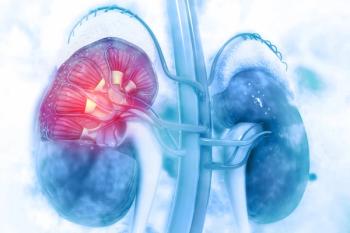
Pazopanib Tops Temsirolimus in Intermediate-Risk Clear Cell RCC
Pazopanib was not associated with prolonged progression-free survival compared with temsirolimus among patients with advanced clear-cell renal cell carcinoma, but a subgroup analysis of intermediate-risk patients offered some reason for optimism.
Pazopanib was not associated with prolonged progression-free survival (PFS) compared with temsirolimus among patients with advanced clear-cell renal cell carcinoma (RCC), according to research presented (
However, a subgroup analysis of PFS for International Metastatic Renal Cell Carcinoma Database Consortium (IMDC) intermediate-risk patients offered some reason for optimism, the researchers reported.
“After adjustment for IMDC risk group, pazopanib yielded a significantly longer PFS than temsirolimus in patients with IMDC intermediate-risk disease,” said lead study author Nizar M. Tannir, MD, FACP, of the University of Texas MD Anderson Cancer Center in Houston. “Pazopanib yielded higher [overall response rates] than temsirolimus, particularly in patients with IMDC intermediate-risk disease.”
Sixty-nine patients with treatment-naive advanced clear-cell RCC and three or more specified risk factors (eg, ECOG performance status of 2, two or more metastatic tumors, hypercalcemia, or time from diagnosis to registration in the study) were randomly assigned to receive either pazopanib (800 mg daily by mouth; n = 35) or 25 mg temsirolimus (intravenously once weekly; n = 34). At disease progression, patients had the option of crossing over to receive the alternative medication. Blind independent radiographic response assessment used RECIST v1.1 criteria.
Two patients from each study arm discontinued treatment due to adverse events. There were no patient deaths.
Interim PFS analysis for trial futility was conducted after 42 disease-progression events. PFS, the primary study endpoint, was not significantly different overall for patients in the pazopanib and temsirolimus study groups (median PFS, 5.2 vs 2.6 months; hazard ratio [HR], 0.70; 95% CI, 0.43–1.14; P = .16).
However, because of an imbalance between the study groups for IMDC risk groups, a test for interaction with treatment arm was undertaken. The interaction between IMDC intermediate-risk group status and treatment arm was significant (P = .04), so the authors conducted a subgroup analysis of PFS for IMDC intermediate-risk patients, and found that pazopanib outperformed temsirolimus (HR, 0.38; 95% CI, 0.16–0.92; P = .03).
However, among IMDC poor-risk patients, PFS was similar for both study arms. “Both agents were found to be ineffective in patients with IMDC poor-risk disease,” Dr. Tannir said.
Overall response rate, a secondary endpoint, was significantly higher among patients on pazopanib than temsirolimus (25.7% vs 6.1%; odds ratio, 5.37; 95% CI, 1.06–27.07; P = .046). Among IMDC intermediate-risk patients, the overall response rate was 40% for patients in the pazopanib group and 0% for patients receiving temsirolimus.
Overall survival, a secondary study endpoint, was not significantly different for patients in the pazopanib and temsirolimus study groups (median overall survival, 12 vs 7.3 months; HR, 0.86; 95% CI, 0.51–1.43; P = .56).
Newsletter
Stay up to date on recent advances in the multidisciplinary approach to cancer.
































































































